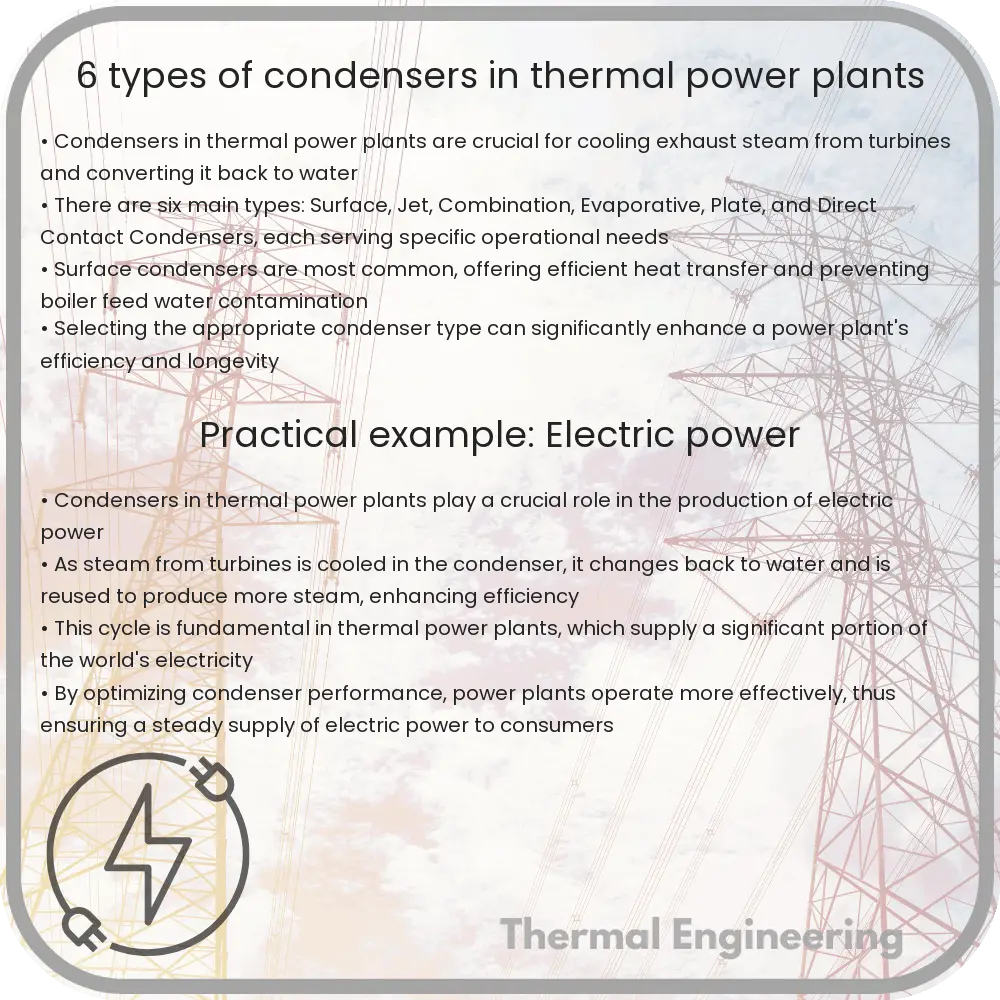Learn about the different types of condensers used in thermal power plants, including surface, jet, and evaporative condensers, and their roles in enhancing efficiency.

Understanding the Types of Condensers in Thermal Power Plants
In thermal power plants, condensers play a crucial role in converting steam from turbines back into liquid water. This process is vital as it enhances the efficiency of the power plant by allowing the steam to be reused. Condensers help in maintaining a low pressure at the exhaust of the steam turbine, which significantly improves the thermodynamic efficiency of the system. Here, we explore six common types of condensers used in thermal power plants and their distinctive features.
1. Surface Condensers
Surface condensers are widely used in thermal power plants. In these types of condensers, steam and cooling water do not mix directly. The steam flows over the outer surface of the tubes within which the cooling water is circulated. The primary advantage of surface condensers is that they prevent boiler water contamination, leading to cleaner and more efficient steam cycles. They typically feature large heat transfer areas and are used extensively in large power plants.
2. Jet Condensers (Direct Contact Type)
Jet condensers, also known as direct contact type condensers, bring the exhaust steam and cooling water into direct contact. This interaction typically occurs in a cone or a series of plates where the cooling water is sprayed directly into the steam, causing condensation. These condensers are appreciated for their simplicity and low capital cost. There are sub-types within jet condensers:
- Low level jet condenser: All the components are installed at a lower level, and the condensate is required to be pumped out.
- High level jet condenser: Installed at a higher level, it utilizes gravity to discharge the condensate naturally.
- Barometric or ejector condenser: Featuring a long vertical discharge pipe, this design uses atmospheric pressure and gravity to aid in the discharge of condensate.
3. Evaporative Condensers
Evaporative condensers combine air and water cooling. In these units, the cooling water is sprayed on the coils through which the steam passes. Simultaneously, air is blown through the condenser to evaporate the water, removing heat from the system. This type is particularly effective in areas where water supply is limited and provides efficient cooling by utilizing the latent heat of vaporization of water.
4. Regenerative Condensers
Regenerative condensers enhance the thermal efficiency by using the heat absorbed during the condensation process to preheat the feedwater entering the boiler. This heat recovery process not only conserves energy but also significantly improves the overall efficiency of the plant. The design and operational complexity of these condensers are higher, but they offer substantial long-term benefits.
5. Air-Cooled Condensers
Unlike other types that rely on water for cooling, air-cooled condensers use air. These are essentially made up of finned tubes over which air is blown or forced, thereby condensing the steam inside the tubes. This type is particularly useful in regions where water resources are scarce. However, their efficiency depends highly on the ambient air conditions.
6. Water-Cooled Condensers
These condensers use water as the primary cooling medium. The water absorbs the heat from the steam, causing it to condense. The heated water is then either cooled for reuse or discharged as waste. Water-cooled condensers are effective but require a continuous and ample supply of cooling water, making them less suitable for areas with water shortages.
Conclusion
Choosing the right type of condenser for a thermal power plant depends on several factors including local environmental conditions, water availability, space constraints, and efficiency requirements. Understanding the different types of condensers and their operations helps in optimizing the design and operation of thermal power plants, thus enhancing their performance and sustainability.